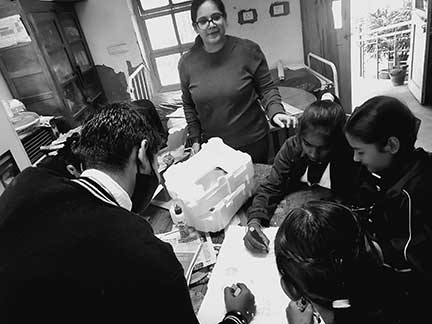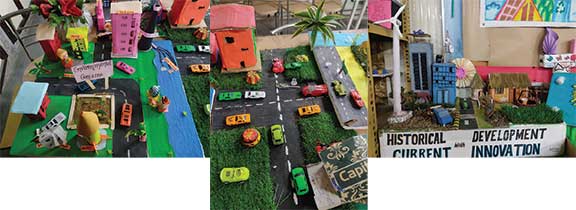Sakshi Uniyal
“Plastic as a nuisance” is a very common essay that almost every school going child in India writes at least once during their 12 years of schooling. The issue of plastic waste is an integral part of the middle school CBSE science curriculum. Throughout grades 6-8, young children learn about the non-biodegradable nature of plastic, how it saturates our daily lives and as a result, chokes our ecosystems. Despite a minimum three year-long engagement with the idea of the potential catastrophe that plastic waste is, Indian children seem unable to grasp the real-life manifestation of problems they discuss within the four walls of the classroom. One of the biggest examples of such a paradox is the usage of thermocol, a type of plastic, to make models on “Say NO to plastic”. Such a sight is very common whenever science fairs or exhibitions are organized in schools.

Chemically, thermocol is expanded polystyrene or EPS, also known as styrofoam. Owing to its low cost, durability, and light weight, it is widely used by school children to prepare a variety of ‘3D models’ for exhibitions or school projects. Another advantage of using thermocol is the ease with which it can be moulded into desired shapes using nothing but a hot paper cutter. However, it carries high environmental costs. The same properties that make thermocol desirable as raw material for school projects make it one of the greatest environmental hazards. Its light weight and high volume make recycling of polystyrene products economically unviable. All such projects made using thermocol, therefore, end up in our already choked landfills. In fact, polystyrene is estimated to occupy a shocking 30 per cent share in landfills worldwide. Yet, questions about environmental costs of polystyrene are conspicuous by their absence from discussions on plastic waste in our classrooms.
If we analyze the usage of thermocol by children more closely, we will find that the paradox is not limited to the one visible on the surface, but goes much deeper to an epistemological level. A cursory examination of the nature of projects made using thermocol reveals its holy grail status among school children. It is the cheapest and quickest answer to all school project problems – be it the depiction of the structure of an atom for the science class, or the solar system for geography class, or different types of quadrilaterals for the mathematics class. The usage of the same material to represent the structure of atoms, the solar system, and quadrilaterals exposes the inability of our children to pay attention to the fundamental properties of materials. Furthermore, it is common to find both atoms and planets represented with roughly similarly sized thermocol circles. This is indicative of a deeper problem in our classrooms which can be seen as a result of the growing dominance of technology in our educational spaces, as described by Marshall McLuhan and Neil Postman.

As our classrooms become more technology driven, we increasingly internalize the idea that technology undoubtedly leads to better learning. We applaud the ability of technology to make even abstract ideas tangible and easily visualizable for learners. In doing so, we disregard the crucial skill that abstraction is in itself. By making 3D animation of an atom visible to learners on a screen, we deprive them of the opportunity to construct the idea of an atom within their own minds and grapple with the confusion such an exercise brings. Absence of such a confusion means that the child will not need to put any effort to resolve it. As a result, learners remain incapable of comprehending the true dimensions of an atom and see no conceptual fallacy in using same sized circles to represent atoms as well as planets. As a grade 11 science student, I myself struggled deeply to visualize the atomic orbitals that were supposedly present inside each atom. My mind could not find overlaps between Bohr’s model of atom that we had been trained to visualize till grade 10 and the sudden new concept of atomic orbitals. I remained puzzled as to how the s, p, d, and f orbitals could fit inside a tiny atom. My inability to gauge the size of an atom as well as to think about a concept as abstract as atomic orbitals is clearly evident here. It took me a long time to resolve this contradiction that remained the highlight of my secondary school chemistry classes. In saying so, I do not mean to negate the value of technology for our classrooms. I am however convinced that a complete surrender to technology as the primary pedagogic tool does more harm than good.
While the introduction of technology can sometimes supplement classroom learning, my apprehension lies in complete erasure of the teacher’s agency in choosing the most appropriate supplementary tool for her classroom. Moreover, it goes without saying that such contradictions as the one I struggled with are quite possibly the norm for lakhs of children in our country. The high degree of abstraction that secondary level science demands is never achieved by a majority of learners and the coping mechanism adopted to deal with it remains rote memorization. Such a strategy causes the formation of watertight boundaries between what is learnt in the classroom and what can be useful in everyday life.
Having drawn such strict boundaries between the classroom and their real life, we have a multitude of learners who do not think there is any connection between the disposable paper cups they use every day for their morning coffee and the mountains of garbage in their city. They can be easily influenced by market forces to become mindless consumers. Our dying planet bears testimony to this single-minded drive for consumption. Since the market thrives on the demand and supply rule, products such as thermocol will continue choking our planet as we use and create more demand for it. This demand can only be curtailed by making our children capable of questioning the need for such products and looking for sustainable alternatives. This can only be possible in classrooms that nurture children’s innate curiosity and do not rely on technology to create meaningful learning experiences for learners.
The Supreme Court’s decision to include environment education as a compulsory subject at all stages highlights the gravity of the situation quite well. Unfortunately, like many other well-intentioned schemes, inclusion of environment education as a separate subject did not work as envisioned at the level of implementation. In many cases, it was reduced to yet another collection of facts which was simply memorized by learners for examinations. Thus, the issue that we tried to address by the introduction of environment education remained unresolved – we continue to see learners using disposable pens made of plastic to write essays on plastic pollution. Even if implemented as envisioned, I believe such a step would be a band-aid solution at best to an issue that demands deep reflection and deliberation by all stakeholders.

Environment education is not limited to isolated bits of information about contemporary environmental issues. By introducing it as a separate subject, we could end up reinforcing the idea of strict compartmentalization of knowledge. Such an idea is contradictory to the nature of knowledge itself, which exists as a unified whole instead of discrete subject-specific units. Development of observation skills in the science classroom will not only enable a learner to observe the parts of a plant, but also the rising piles of plastic waste in her immediate environment. Similarly, the mathematization of a child’s thought process will empower her to estimate the environmental cost of her daily life decisions, such as repairing leaky taps or taking a public transport as opposed to her private vehicle. A holistic view of knowledge would thus help young children in transferring the ideas and skills learnt in the classroom to a variety of real-life situations. It is only then that we can expect children to see the relevance of classroom discussions to their immediate environment and ultimately the whole ecosystem. Such a child would be able to connect the usage of thermocol for her project to the news article she reads about the garbage mountain in her city and feel confident enough to reject thermocol in favour of more sustainable alternatives. Raising young children capable of doing so would be our most significant step towards the conservation and protection of our environment.
The author is a science teacher who has taught in a popular private school in Delhi as well as in a chain of central government schools. She specializes in science and inclusive education. She has been working on creating science centres that offer specialized learning opportunities to children in environment conservation. She can be reached at sakshiuniyal1993@gmail.com.
